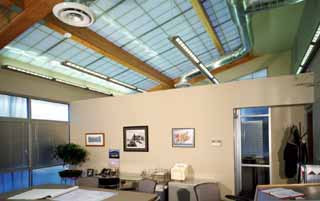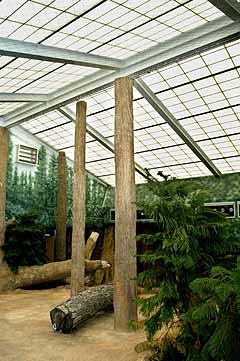
Surveys
DJC.COM
July 28, 2005
Let the sunshine in, efficiently
Cabot Corp.

Photo courtesy Kilgore Architectural Products
Kilgore Architectural Products used Kalwall R-20 panels filled with Nanogel for its offices in Spokane.
|
As green building migrates from Europe and proliferates in the United States, new technologies have been harnessed to increase the quality and quantity of daylighting brought to indoor environments without sacrificing energy efficiency.
Green building is the practice of increasing the efficiency in which buildings and their sites use energy and materials. These buildings are designed to significantly reduce or eliminate negative impacts on the environment and minimize the depletion of natural resources.
Green building is an essential component of sustainable design and development, giving property owners lower operating costs while improving the health and well-being of their occupants.
Mood lighting
There are varying aspects of green building, one of which is daylighting applications that include glazed facades, skylights and translucent roofing systems. The benefits of natural daylight are widely recognized to contribute to the well-being of occupants.
Fenestration systems have been the weak energy link in building envelopes. Technology advancements, including multiple glazing systems, have improved fenestration systems, but not nearly enough to comply with many of today's new and pending building codes.
A simple solution involves the use of translucent aerogel insulation to improve aesthetics, reduce energy costs and enhance the indoor environment.

Photo courtesy Cabot Corp.
The Milwaukee Zoo used panels insulated with translucent aerogel to daylight a big cat exhibit without sacrificing energy efficiency.
|
Cabot developed a translucent aerogel called Nanogel to address the need for energy-efficient building materials and stricter energy building codes. The aerogel is the lightest solid on earth and is based on Cabot's surface modification and fine-particle manufacturing technology.
Due to its composition of 95 percent air, low density and porosity, Nanogel is a poor conductor of heat, therefore a great thermal insulator. It provides a superior combination of thermal and sound insulation as well as light transmission and diffusion over other insulation materials. These benefits offer new design solutions for architects and commercial builders where both natural daylight levels and energy efficiency are required. So much so, that NASA first used aerogels as insulation in aerospace applications.
Building green for the big cats
The art of green building daylighting applications has taken off across the country in structures such as homes, schools, atriums and zoos.
The newly opened big cat exhibit at the Milwaukee Zoo is one of the latest building sites moving toward this environmentally-friendly construction alternative.
Wisconsin is one of the many states in the country enforcing stricter energy codes. One of the first building projects under these stricter guidelines was a complete retrofit of the energy-inefficient, 1960s-era concrete and sprayed concrete rockwork big cat building. The project included the removal of the entire built-up roofing system and replacing nearly 50 percent of the roof area with ridge- and shed-configuration skylights. The lion's den has an approximately 34-by-34-foot ridge skylight that contains Nanogel, making it the first commercial building of its kind to house large animals while keeping energy costs down.
"One unintended effect of this mandate is that the healthy effects of daylight on mammals, including humans, are minimized for the sake of energy efficiency," said Dale Nielsen of Nielsen Building Systems in Wisconsin, which provided the roofing for the exhibit.
With this in mind, the daylight needs of the animals were of primary concern to Bruce Beehler, deputy zoo director, who oversees animal exhibits and buildings including the popular feline exhibit.
| Where to get Aerogel |
|
DeaMor Associates,
Seattle (206) 352-9466 or
www.deamor.com Kilgore Architectural Products, Spokane (509) 893-0750 or www.kilgoretecproducts.com |
"A natural light cycle and a feeling of openness are necessary to create a healthy indoor environment for the animals," Beehler said. "Studies show that daylight positively effects the reproductive cycles of animals and is essential for the production of vitamin D."
With the increased size of the exhibit and a more natural daylight environment, the zoo has room for more cats in the feline house. New additions are planned, and hopes are high that the zoo will be able to breed at least two species, including lions and Siberian tigers.
Many executives, builders and developing companies involved in the green building boom have noticed the overwhelming benefits of this environmental trend. Many have reported an increase in construction activity and expect this growth to accelerate. The function of green building and energy-efficient daylighting alternatives is an important trend, and a necessity to improve the environment we all share.
James Satterwhite is director of Nanogel building and construction for Boston's Cabot Corp., a specialty chemicals and materials company.
Other Stories:
- Green buildings can spark economic growth
- Whitewater parks move into the mainstream
- Momentum is building to reduce global warming
- Turning waste into environmental, social good
- The hazards of flicking on a light switch
- A road map for Columbia Basin's future
- Canada: A lesson in salmon recovery planning
- Better mapping may change development rules
- What makes a green consumer?
- Farmers, government team up to save fish
- Seattle law firms end their paper chase
- Food industry puts energy efficiency on the menu
- A solution to Hood Canal's lurking pollution?
- Stretching Washington's water supply
- Saving salmon: Now the hard work begins
- Seattle finds gold with sustainable strategies
Copyright ©2009 Seattle Daily Journal and DJC.COM.
Comments? Questions? Contact us.